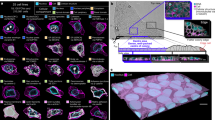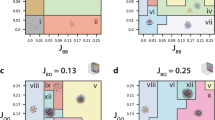Abstract
The spatiotemporal organization of membrane-associated molecules is central to the regulation of cellular signals. Powerful new microscopy techniques enable the three-dimensional visualization of localization and activation of these molecules; however, the quantitative interpretation and comparison of molecular organization on the three-dimensional cell surface remains challenging because cells themselves vary greatly in morphology. Here we introduce u-signal3D, a framework to assess the spatial scales of molecular organization at the cell surface in a cell-morphology-invariant manner. We validated the framework by analyzing synthetic signaling patterns painted onto observed cell morphologies, as well as measured distributions of cytoskeletal and signaling molecules. To demonstrate the framework’s versatility, we further compared the spatial organization of cell surface signals both within, and between, cell populations, and powered an upstream machine-learning-based analysis of signaling motifs.
This is a preview of subscription content, access via your institution
Access options
Access Nature and 54 other Nature Portfolio journals
Get Nature+, our best-value online-access subscription
$29.99 / 30 days
cancel any time
Subscribe to this journal
Receive 12 digital issues and online access to articles
$99.00 per year
only $8.25 per issue
Buy this article
- Purchase on Springer Link
- Instant access to full article PDF
Prices may be subject to local taxes which are calculated during checkout





Similar content being viewed by others
Data availability
All image data that support the findings of this study are available in a Zenodo repository (https://doi.org/10.5281/zenodo.8166238)54. This repository comprises a collection of high-resolution 3D cell images captured using light-sheet microscopy. These images have been previously published, and the origin of the dataset is referenced in the Methods section. Source data for Figs. 2–5 are provided with this manuscript.
Code availability
All analysis was performed in a custom software package (u-signal3D) written in MATLAB (Mathworks), which is available as a frozen version in a Zenodo repository (https://doi.org/10.5281/zenodo.8222824)55 and as an updated repository at (https://github.com/DanuserLab/u-signal3D).
References
Jordan, J. D., Landau, E. M. & Iyengar, R. Signaling networks: the origins of cellular multitasking. Cell 103, 193–200 (2000).
Kholodenko, B. N. Cell-signalling dynamics in time and space. Nat. Rev. Mol. Cell Biol. 7, 165–176 (2006).
Neves, S. R. et al. Cell shape and negative links in regulatory motifs together control spatial information flow in signaling networks. Cell 133, 666–680 (2008).
Jaqaman, K. & Ditlev, J. A. Biomolecular condensates in membrane receptor signaling. Curr. Opin. Cell Biol. 69, 48–54 (2021).
Edidin, M. Patches, posts and fences: proteins and plasma membrane domains. Trends Cell Biol. 2, 376–380 (1992).
Schmick, M. & Bastiaens, P. I. H. The interdependence of membrane shape and cellular signal processing. Cell 156, 1132–1138 (2014).
Driscoll, M. K. & Danuser, G. Quantifying modes of 3D cell migration. Trends Cell Biol. 25, 749–759 (2015).
Elliott, H. et al. Myosin II controls cellular branching morphogenesis and migration in three dimensions by minimizing cell-surface curvature. Nat. Cell Biol. 17, 137–147 (2015).
O’Shaughnessy, E. C. et al. Software for lattice light-sheet imaging of FRET biosensors, illustrated with a new Rap1 biosensor. J. Cell Biol. 218, 3153–3160 (2019).
Peng, H. C. Bioimage informatics: a new area of engineering biology. Bioinformatics 24, 1827–1836 (2008).
Schauer, K. et al. Probabilistic density maps to study global endomembrane organization. Nat. Methods 7, 560–566 (2010).
Biot, E. et al. Strategy and software for the statistical spatial analysis of 3D intracellular distributions. Plant J. 87, 230–242 (2016).
Pecot, T., Zengzhen, L., Boulanger, J., Salamero, J. & Kervrann, C. A quantitative approach for analyzing the spatio-temporal distribution of 3D intracellular events in fluorescence microscopy. eLife 7, 32311 (2018).
Peng, T. & Murphy, R. F. Image‐derived, three‐dimensional generative models of cellular organization. Cytometry A 79, 383–391 (2011).
Taubin, G. A signal processing approach to fair surface design. In Proc. 22nd Annual Conference on Computer Graphics and Interactive Techniques 351–358 (ACM, 1995).
Vallet, B. & Lévy, B. Spectral geometry processing with manifold harmonics. In Comput Graph Forum 251–260 (Wiley, 2008).
Reuter, M., Wolter, F.-E. & Peinecke, N. Laplace–Beltrami spectra as ‘Shape-DNA’ of surfaces and solids. Comput. Aided Des. 38, 342–366 (2006).
Ducroz, C., Olivo-Marin, J. C. & Dufour, A. Characterization of cell shape and deformation in 3D using spherical harmonics. In 2012 9th IEEE International Symposium on Biomedical Imaging (ISBI) 848–851 (IEEE, 2012).
Cammarasana, S. & Patane, G. Localised and shape-aware functions for spectral geometry processing and shape analysis: a survey & perspectives. Comput. Graph. UK 97, 1–18 (2021).
Choukroun, Y., Shtern, A., Bronstein, A. & Kimmel, R. Hamiltonian operator for spectral shape. Anal. IEEE Trans. Vis. Comput. Graph. 26, 1320–1331 (2020).
Melzi, S., Rodola, E., Castellani, U. & Bronstein, M. M. Localized manifold harmonics for spectral shape analysis. Comput Graph. Forum 37, 20–34 (2018).
Neumann, T., Varanasi, K., Theobalt, C., Magnor, M. & Wacker, M. Compressed manifold modes for mesh processing. Comput Graph. Forum 33, 35–44 (2014).
Belkin, M., Sun, J. & Wang, Y. S. Discrete Laplace operator on meshed surfaces. In Proc. 24th Annual Symposium on Computational Geometry (SGG'08) 278–287 (ACM, 2008).
Sharp, N. & Crane, K. A Laplacian for nonmanifold triangle meshes. Comput Graph Forum 39, 69–80 (2020).
Petronetto, F., Paiva, A., Helou, E. S., Stewart, D. E. & Nonato, L. G. Mesh-free discrete Laplace–Beltrami operator. Comput Graph Forum 32, 214–226 (2013).
Angenent, S., Haker, S., Tannenbaum, A. & Kikinis, R. On the Laplace–Beltrami operator and brain surface flattening. IEEE Trans. Med. Imaging 18, 700–711 (1999).
Klein, A. et al. Mindboggling morphometry of human brains. PLoS Comput. Biol. 13, e1005350 (2017).
Graichen, U. et al. SPHARA–a generalized spatial Fourier analysis for multi-sensor systems with non-uniformly arranged sensors: application to EEG. PLoS ONE 10, e0121741 (2015).
Huang, S. G., Chung, M. K., Qiu, A. & Alzheimer’s Disease Neuroimaging, I. Fast mesh data augmentation via Chebyshev polynomial of spectral filtering. Neural Netw. 143, 198–208 (2021).
Qiu, A., Bitouk, D. & Miller, M. I. Smooth functional and structural maps on the neocortex via orthonormal bases of the Laplace–Beltrami operator. IEEE Trans. Med. Imaging 25, 1296–1306 (2006).
Viana, M. P. et al. Integrated intracellular organization and its variations in human iPS cells. Nature 613, 345–354 (2023).
Ruan, X. & Murphy, R. F. Evaluation of methods for generative modeling of cell and nuclear shape. Bioinformatics 35, 2475–2485 (2019).
Shen, L., Farid, H. & McPeek, M. A. Modeling three-dimensional morphological structures using spherical harmonics. Evolution 63, 1003–1016 (2009).
Driscoll, M. K. et al. Robust and automated detection of subcellular morphological motifs in 3D microscopy images. Nat. Methods 16, 1037–1044 (2019).
Pinkall, U. & Polthier, K. Computing discrete minimal surfaces and their conjugates. Exp. Math. 2, 15–36 (1993).
Ovsjanikov, M. et al. Computing and processing correspondences with functional maps In SA '16: SIGGRAPH ASIA 2016 Courses 1–60 (ACM, 2016).
Driscoll, M. K. et al. Proteolysis-free cell migration through crowded environments via mechanical worrying. Preprint at https://www.biorxiv.org/content/10.1101/2020.11.09.372912v3 (2022).
Ronchi, V. Forty years of history of a grating interferometer. Appl. Opt. 3, 437–451 (1964).
Weems, A. D. et al. Blebs promote cell survival by assembling oncogenic signalling hubs. Nature 615, 517–525 (2023).
Welf, E. S. et al. Quantitative multiscale cell imaging in controlled 3D microenvironments. Dev. Cell 36, 462–475 (2016).
Charras, G. & Paluch, E. Blebs lead the way: how to migrate without lamellipodia. Nat. Rev. Mol. Cell Biol. 9, 730–736 (2008).
Aigerman, N. & Lipman, Y. Orbifold tutte embeddings. ACM Trans. Graph. 34, 190:191–190:112 (2015).
Charras, G. T., Coughlin, M., Mitchison, T. J. & Mahadevan, L. Life and times of a cellular bleb. Biophys. J. 94, 1836–1853 (2008).
Dean, K. M., Roudot, P., Welf, E. S., Danuser, G. & Fiolka, R. Deconvolution-free subcellular imaging with axially swept light sheet microscopy. Biophys. J. 108, 2807–2815 (2015).
Otsu, N. A threshold selection method from gray-level histograms. IEEE Trans. Syst. Man Cybern. 9, 62–66 (1979).
Desbrun, M., Meyer, M., Schroder, P. & Barr, A. H. Implicit fairing of irregular meshes using diffusion and curvature flow. In SIGGRAPH '99: Proc. 26th Annual Conference On Computer Graphics and Interactive Techniques 317–324 (ACM, 1999).
Demanet, L. Painless, Highly Accurate Discretizations of the Laplacian on a Smooth Manifold Technical Report (Stanford University, 2006).
Mayer, U. F. Numerical solutions for the surface diffusion flow in three space dimensions. Comput. Appl. Math. 20, 361–379 (2001).
Xu, G. Discrete Laplace–Beltrami operators and their convergence. Comput. Aided Des. 21, 767–784 (2004).
Solomon, J., Guibas, L. & Butscher, A. Dirichlet energy for analysis and synthesis of soft maps. In Comput Graph Forum Vol. 32, 197–206 (Wiley, 2013).
Sethian, J. A. Fast marching methods. SIAM Rev. 41, 199–235 (1999).
Goddard, T. D. et al. UCSF ChimeraX: meeting modern challenges in visualization and analysis. Protein Sci. 27, 14–25 (2018).
Schneider, C. A., Rasband, W. S. & Eliceiri, K. W. NIH Image to ImageJ: 25 years of image analysis. Nat. Meth. 9, 671–675 (2012).
Mazloom-Farsibaf, H., Zou, Q., Hsieh, R., Driscoll, M. K. & Danuser, G. Data Repository Supporting “Cellular Harmonics for the Morphology-Invariant Analysis of Molecular Organization at the Cell Surface" (Zenodo, 2023); https://doi.org/10.5281/zenodo.8166238
Zou, Q. DanuserLab/u-signal3D (Zenodo, 2023); https://doi.org/10.5281/zenodo.8222824
Acknowledgements
We would like to thank M. Ovsjanikov, J. Noh, F. Zhou and J. Huh for fruitful discussions, and A. Weems, E. Welf, R. Fiolka and K. Dean for data collection. This work was supported by grant no. K99GM123221 to M.K.D., and grant nos. R35GM136428 and RM1GM145399 to G.D.
Author information
Authors and Affiliations
Contributions
H.M-.F. and M.K.D. conceived and designed the project. M.K.D. and G.D supervised the project. H.M.-F. wrote the codes for the package and M.K.D, Q.Z., and R.H. helped with writing and debugging the codes. H.M.-F. wrote the manuscript. M.K.D. and G.D helped with writing and editing the manuscript. All authors read and approved the final manuscript
Corresponding authors
Ethics declarations
Competing interests
The authors declare no competing interests.
Peer review
Peer review information
Nature Computational Science thanks Bruno Goud, Kristine Schauer and the other, anonymous, reviewer(s) for their contribution to the peer review of this work. Primary handling editor Ananya Rastogi, in collaboration with the Nature Computational Science team.
Additional information
Publisher’s note Springer Nature remains neutral with regard to jurisdictional claims in published maps and institutional affiliations.
Supplementary information
Supplementary Information
Supplementary Figs. 1–10.
Supplementary Video 1
Molecular distribution over time: surface rendering of an MV3 melanoma cell expressing GFP-AktPH, a marker of PI3K activity. The red color indicates regions of high signaling activity and yellow color regions of low activity (see the color bar in Fig. 1b).
Supplementary Video 2
Three-dimensional molecular organization of cytosol marker and CyOFP-tractin at the surface of an MV3 melanoma cell. Surface rendering of an MV3 melanoma cell expressing cytosolic GFP and CyOFP-tractin (see Fig. 4a).
Supplementary Video 3
Three-dimensional raw image of cytosol marker and CyOFP-tractin on an MV3 melanoma cell. Maximum intensity projection along the y-axis of raw volumetric of cytosolic GFP and CyOFP-tractin signals onto the cell surface (see Fig. 4a). Both signals display patchy organization, however, the CyOFP-tractin signal is more structured, as expected.
Supplementary Video 4
PI3K activity redistribution on an MV3 melanoma cell under PI3K inhibition. Surface rendering of an MV3 melanoma cell expressing GFP-AktPH, a marker of PI3K activity, after adding PI3K inhibitor (left). Energy density spectra of the PI3K activity redistribution under PI3K inhibition.
Supplementary Data
Statistical source data for Supplementary Figs. 2, 3 and 6–10.
Source data
Source Data Fig. 2
Numerical source data
Source Data Fig. 3
Numerical source data
Source Data Fig. 4
Numerical source data
Source Data Fig. 5
Numerical source data
Rights and permissions
Springer Nature or its licensor (e.g. a society or other partner) holds exclusive rights to this article under a publishing agreement with the author(s) or other rightsholder(s); author self-archiving of the accepted manuscript version of this article is solely governed by the terms of such publishing agreement and applicable law.
About this article
Cite this article
Mazloom-Farsibaf, H., Zou, Q., Hsieh, R. et al. Cellular harmonics for the morphology-invariant analysis of molecular organization at the cell surface. Nat Comput Sci 3, 777–788 (2023). https://doi.org/10.1038/s43588-023-00512-4
Received:
Accepted:
Published:
Issue Date:
DOI: https://doi.org/10.1038/s43588-023-00512-4



